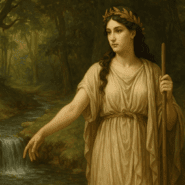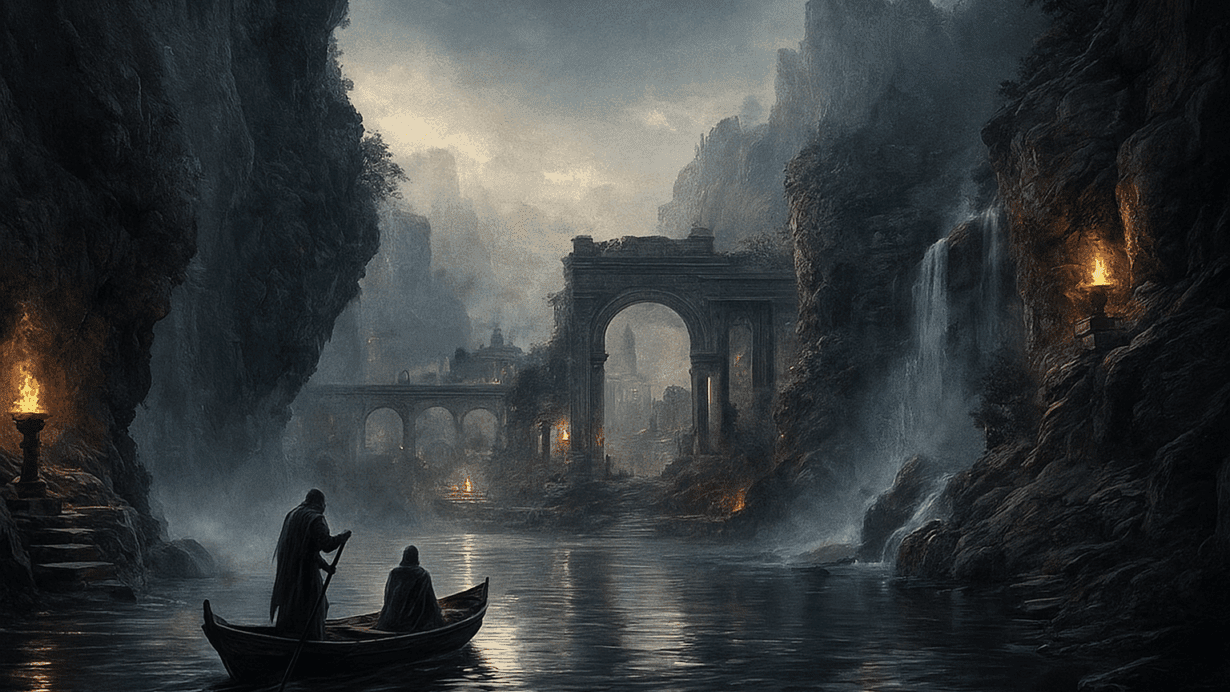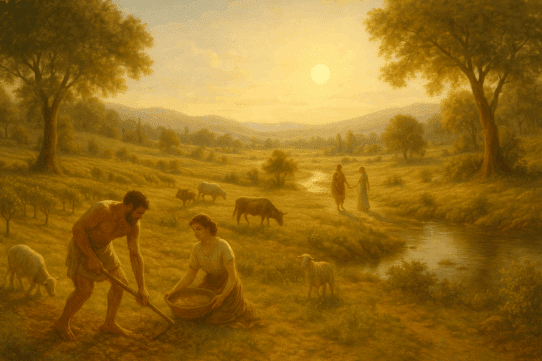QUICK SUMMARY
The Roman Underworld was a vast spiritual landscape that shaped how Romans understood death, memory, justice, and rebirth. This guide maps its geography, its guardians, and the journey every soul was believed to take beyond the veil.
For the Romans, the Underworld was not a single place but an entire spiritual cosmos lying beneath the living world. It blended ancient Italian beliefs with Greek myth, Etruscan influences, and Rome’s own evolving view of death, duty, and divine order. Far from being a realm of pure terror, it was a structured universe, complete with rivers, judges, guardians, punishments, rewards, and sacred thresholds that marked the soul’s path into eternity.
This landscape reveals how the Romans confronted mortality and how they linked remembrance, ritual, and moral responsibility to the destiny of every human soul. Mapping the Roman Underworld is a way of understanding their moral universe.
The Threshold: Crossing Into the Realm of the Dead
The journey began at the moment of death, when the soul departed the body and approached the shadowy boundary separating the living from the Underworld. Romans believed that proper funeral rites were essential for crossing this threshold. Without burial, a spirit risked becoming a lemur or restless ghost, condemned to wander without rest.
Families placed a coin, usually an obol, under the tongue of the deceased. This offering paid the ferryman, echoing Greek tradition but widely adopted throughout Rome. Only with this payment could the soul enter the next stage of the journey.
Avernus: The Gateway
One of the most famous entrances to the Underworld was Lake Avernus near Cumae. Its dark waters, rising vapors, and deep caverns inspired generations of poets and priests to see it as a passage to the world of the dead. According to Roman legend, this was the route Aeneas took when guided by the Sibyl to meet the spirit of his father, Anchises.
Avernus symbolized transition: a point where the living world thinned and the unseen realm opened.
The Five Rivers of the Roman Underworld
The Underworld was imagined as a network of sacred rivers whose waters shaped every soul’s fate. Borrowed from Greek tradition yet deeply woven into Roman thought, each river represented one dimension of the journey after death.
Styx: The River of Oaths
The Styx was a river of unbreakable promises. The gods themselves swore by its waters, and any oath made upon it carried cosmic weight.
Acheron: The River of Woe
Acheron formed the boundary ferried by Charon, the grim boatman. Souls wept along its banks, awaiting passage to judgment.
Cocytus: The River of Lamentation
This river amplified grief. Its waters echoed with mourning voices that drifted across the darkest reaches of the realm.
Phlegethon: The River of Fire
Flaming currents coursed through the Underworld, a river whose fiery nature symbolized cleansing, torment, and divine punishment.
Lethe: The River of Forgetfulness
In certain traditions, souls drank from Lethe to erase memories of earthly life before rebirth. This concept influenced later Roman philosophical thought about memory and renewal.
Judgment and Destiny
Once ferried across the Acheron, souls approached the place of judgment. Roman poets described three divine judges, adapted from Greek tradition, who weighed a life’s deeds and determined each spirit’s destination.
- Rhadamanthus judged the Eastern dead
- Minos presided over difficult cases
- Aeacus judged the souls of the Western world
To the Roman mind, judgment was stern but fair. Life was measured by duty, loyalty, piety, and moral conduct.
Domains of the Blessed and the Damned
After judgment, souls were sent to one of three principal realms within the Underworld. This tripartite structure reflected Rome’s emphasis on order and hierarchy.
Tartarus: Punishment for the Wicked
Tartarus was the deepest chasm of the Underworld, the place where oath-breakers, tyrants, traitors, and the most notorious offenders faced eternal punishment. Roman writers described colossal gates, walls of bronze, and monstrous guardians who patrolled its fiery expanses.
Tartarus served as a cosmic warning: the price of moral corruption was eternal suffering.
The Asphodel Fields: A Neutral Afterlife
For most souls, the destination was neither glory nor torment but a vast, misty plain. The Asphodel Fields were described as a quiet, shadowed expanse where ordinary spirits wandered peacefully. Life continued in muted form, a pale reflection of earthly existence.
This neutral afterlife resonated with Roman ethics. A life lived with modest virtue was rewarded with tranquil rest.
The Elysian Fields: Paradise for Heroes
The Elysian Fields, or Elysium, were reserved for the greatest heroes, poets, rulers, and champions of Rome’s values. Here the air was bright, the meadows green, and the spirits joyful. Time held no weight in this blissful realm.
Romans believed that Elysium reflected divine favor earned through excellence, bravery, or extraordinary service to the state.
Guardians and Spirits of the Underworld
The Roman Underworld was populated by powerful beings who enforced cosmic law. Each figure represented a crucial aspect of Rome’s vision of death and destiny.
Charon
The ferryman was relentless and impartial, conveying souls only when paid and only if properly buried.
Cerberus
The three-headed hound guarded the gates, ensuring souls entered but never returned.
The Manes
These ancestral spirits represented the dead who joined the collective of Rome’s honored forebears. Families offered rituals at Parentalia and Lemuria to keep these spirits at peace.
The Furies
Symbols of vengeance, the Furies pursued those who violated sacred oaths or committed grave injustices.
Their presence reminded Romans that justice extended beyond death.
Roman Rituals That Shaped the Underworld
Rituals were essential to the Roman vision of eternal order. Proper rites determined how peacefully a soul could travel through the Underworld.
Parentalia
A festival honoring ancestral spirits. Through offerings and remembrance, families ensured harmony between the living and the dead.
Lemuria
A night-time rite designed to appease restless ghosts. The head of the household cast black beans behind him to banish malevolent spirits.
Terminalia
A festival tied to boundary-stones, reminding Romans that divine order governed both the land and the soul.
These rituals reflected Rome’s belief that death was not severance but a continued relationship.
Philosophical Interpretations of the Afterlife
While mythology provided the imagery, Roman philosophers reshaped the Underworld into a more allegorical landscape.
Stoic Views
Stoics saw the Underworld as symbolic rather than literal. The soul either dissolved into the cosmic fire or endured as a spark of reason.
Epicurean Views
Epicureans denied an afterlife entirely, arguing that death signified the end of consciousness.
Platonic Influence
Some Roman thinkers adopted Greek ideas of reincarnation, linking Lethe to spiritual renewal.
These interpretations show how Roman thought blended mythology with intellectual inquiry.
Legacy of the Roman Underworld
The Roman vision of the Underworld profoundly influenced medieval Christianity, Renaissance art, and modern depictions of Hell and the afterlife. Many structures — rivers, gates, judges, realms — echo through modern literature, video games, and popular culture.
What survives most strongly is the Roman belief that memory, ritual, and moral duty shape one’s destiny in life and beyond. The Underworld was a mirror of society: ordered, moral, and deeply intertwined with family and tradition.








